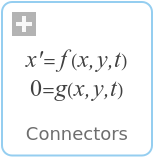WOLFRAM SYSTEM MODELER
ConnectorsConnectors |
|
Wolfram Language
SystemModel["Modelica.UsersGuide.Connectors"]

Information
This information is part of the Modelica Standard Library maintained by the Modelica Association.
The Modelica standard library defines the most important elementary connectors in various domains. If any possible, a user should utilize these connectors in order that components from the Modelica Standard Library and from other libraries can be combined without problems. The following elementary connectors are defined (the meaning of potential, flow, and stream variables is explained in section "Connector Equations" below):
| domain | potential variables |
flow variables |
stream variables |
connector definition | icons |
| electrical analog |
electrical potential | electrical current | Modelica.Electrical.Analog.Interfaces
Pin, PositivePin, NegativePin |
 | |
| electrical polyphase |
vector of electrical pins | Modelica.Electrical.Polyphase.Interfaces
Plug, PositivePlug, NegativePlug |
 | ||
| electrical space phasor |
2 electrical potentials | 2 electrical currents | Modelica.Electrical.Machines.Interfaces
SpacePhasor |
 | |
| quasi-static single-phase |
complex electrical potential | complex electrical current |
Modelica.Electrical.QuasiStatic.SinglePhase.Interfaces
Pin, PositivePin, NegativePin |
 | |
| quasi-static polyphase |
vector of quasi-static single-phase pins | Modelica.Electrical.QuasiStatic.Polyphase.Interfaces
Plug, PositivePlug, NegativePlug |
 | ||
| electrical digital |
Integer (1..9) | Modelica.Electrical.Digital.Interfaces
DigitalSignal, DigitalInput, DigitalOutput |
 | ||
| magnetic flux tubes |
magnetic potential | magnetic flux |
Modelica.Magnetic.FluxTubes.Interfaces
MagneticPort, PositiveMagneticPort, NegativeMagneticPort |
 | |
| magnetic fundamental wave |
complex magnetic potential | complex magnetic flux |
Modelica.Magnetic.FundamentalWave.Interfaces
MagneticPort, PositiveMagneticPort, NegativeMagneticPort |
 | |
| translational | distance | cut-force | Modelica.Mechanics.Translational.Interfaces
Flange_a, Flange_b |
 | |
| rotational | angle | cut-torque | Modelica.Mechanics.Rotational.Interfaces
Flange_a, Flange_b |
 | |
| 3-dim. mechanics |
position vector orientation object |
cut-force vector cut-torque vector |
Modelica.Mechanics.MultiBody.Interfaces
Frame, Frame_a, Frame_b, Frame_resolve |
 | |
| simple fluid flow |
pressure specific enthalpy |
mass flow rate enthalpy flow rate |
Modelica.Thermal.FluidHeatFlow.Interfaces
FlowPort, FlowPort_a, FlowPort_b |
 | |
| thermo fluid flow |
pressure | mass flow rate | specific enthalpy mass fractions |
Modelica.Fluid.Interfaces
FluidPort, FluidPort_a, FluidPort_b |
 |
| heat transfer |
temperature | heat flow rate | Modelica.Thermal.HeatTransfer.Interfaces
HeatPort, HeatPort_a, HeatPort_b |
 | |
| blocks |
Real variable Integer variable Boolean variable |
Modelica.Blocks.Interfaces
RealSignal, RealInput, RealOutput IntegerSignal, IntegerInput, IntegerOutput BooleanSignal, BooleanInput, BooleanOutput |
 | ||
| complex blocks |
Complex variable | Modelica.ComplexBlocks.Interfaces
ComplexSignal, ComplexInput, ComplexOutput |
 | ||
| state machine |
Boolean variables (occupied, set, available, reset) |
Modelica.StateGraph.Interfaces
Step_in, Step_out, Transition_in, Transition_out |
 | ||
In all domains, usually 2 connectors are defined. The variable declarations are identical, only the icons are different in order that it is easy to distinguish connectors of the same domain that are attached at the same component.
Hierarchical Connectors
Modelica supports also hierarchical connectors, in a similar way as hierarchical models. As a result, it is, e.g., possible, to collect elementary connectors together. For example, an electrical plug consisting of two electrical pins can be defined as:
connector Plug import Modelica.Electrical.Analog.Interfaces; Interfaces.PositivePin phase; Interfaces.NegativePin ground; end Plug;
With one connect(..) equation, either two plugs can be connected (and therefore implicitly also the phase and ground pins) or a Pin connector can be directly connected to the phase or ground of a Plug connector, such as "connect(resistor.p, plug.phase)".
Connector Equations
The connector variables listed above have been basically determined with the following strategy:
- State the relevant balance equations and boundary conditions of a volume for the particular physical domain.
- Simplify the balance equations and boundary conditions of (1) by taking the limit of an infinitesimal small volume (e.g., thermal domain: temperatures are identical and heat flow rates sum up to zero).
- Use the variables needed for the balance equations and boundary conditions of (2) in the connector and select appropriate Modelica prefixes, so that these equations are generated by the Modelica connection semantics.
The Modelica connection semantics is sketched at hand of an example: Three connectors c1, c2, c3 with the definition
connector Demo Real p; // potential variable flow Real f; // flow variable stream Real s; // stream variable end Demo;
are connected together with
connect(c1,c2); connect(c1,c3);
then this leads to the following equations:
// Potential variables are identical
c1.p = c2.p;
c1.p = c3.p;
// The sum of the flow variables is zero
0 = c1.f + c2.f + c3.f;
/* The sum of the product of flow variables and upstream stream variables is zero
(this implicit set of equations is explicitly solved when generating code;
the "<undefined>" parts are defined in such a way that
inStream(..) is continuous).
*/
0 = c1.f*(if c1.f > 0 then s_mix else c1.s) +
c2.f*(if c2.f > 0 then s_mix else c2.s) +
c3.f*(if c3.f > 0 then s_mix else c3.s);
inStream(c1.s) = if c1.f > 0 then s_mix else <undefined>;
inStream(c2.s) = if c2.f > 0 then s_mix else <undefined>;
inStream(c3.s) = if c3.f > 0 then s_mix else <undefined>;
